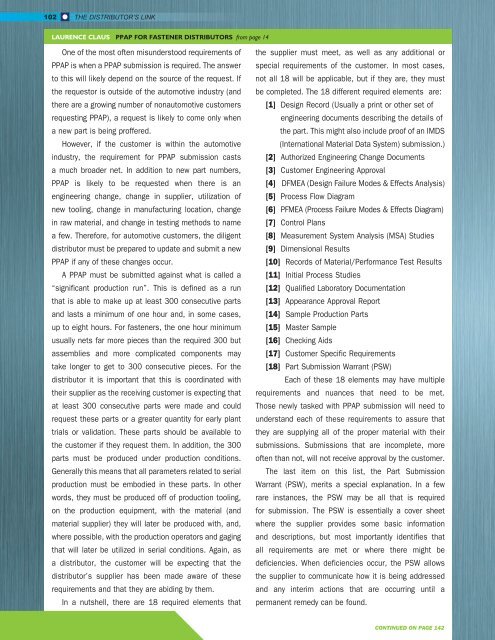SUMMER 2016
Distributor's Link Magazine Summer Issue 2016 / Vol 39 No3
Distributor's Link Magazine Summer Issue 2016 / Vol 39 No3
Create successful ePaper yourself
Turn your PDF publications into a flip-book with our unique Google optimized e-Paper software.
102<br />
THE DISTRIBUTOR’S LINK<br />
LAURENCE CLAUS PPAP FOR FASTENER DISTRIBUTORS from page 14<br />
One of the most often misunderstood requirements of<br />
PPAP is when a PPAP submission is required. The answer<br />
to this will likely depend on the source of the request. If<br />
the requestor is outside of the automotive industry (and<br />
there are a growing number of nonautomotive customers<br />
requesting PPAP), a request is likely to come only when<br />
a new part is being proffered.<br />
However, if the customer is within the automotive<br />
industry, the requirement for PPAP submission casts<br />
a much broader net. In addition to new part numbers,<br />
PPAP is likely to be requested when there is an<br />
engineering change, change in supplier, utilization of<br />
new tooling, change in manufacturing location, change<br />
in raw material, and change in testing methods to name<br />
a few. Therefore, for automotive customers, the diligent<br />
distributor must be prepared to update and submit a new<br />
PPAP if any of these changes occur.<br />
A PPAP must be submitted against what is called a<br />
“significant production run”. This is defined as a run<br />
that is able to make up at least 300 consecutive parts<br />
and lasts a minimum of one hour and, in some cases,<br />
up to eight hours. For fasteners, the one hour minimum<br />
usually nets far more pieces than the required 300 but<br />
assemblies and more complicated components may<br />
take longer to get to 300 consecutive pieces. For the<br />
distributor it is important that this is coordinated with<br />
their supplier as the receiving customer is expecting that<br />
at least 300 consecutive parts were made and could<br />
request these parts or a greater quantity for early plant<br />
trials or validation. These parts should be available to<br />
the customer if they request them. In addition, the 300<br />
parts must be produced under production conditions.<br />
Generally this means that all parameters related to serial<br />
production must be embodied in these parts. In other<br />
words, they must be produced off of production tooling,<br />
on the production equipment, with the material (and<br />
material supplier) they will later be produced with, and,<br />
where possible, with the production operators and gaging<br />
that will later be utilized in serial conditions. Again, as<br />
a distributor, the customer will be expecting that the<br />
distributor’s supplier has been made aware of these<br />
requirements and that they are abiding by them.<br />
In a nutshell, there are 18 required elements that<br />
the supplier must meet, as well as any additional or<br />
special requirements of the customer. In most cases,<br />
not all 18 will be applicable, but if they are, they must<br />
be completed. The 18 different required elements are:<br />
[1] Design Record (Usually a print or other set of<br />
engineering documents describing the details of<br />
the part. This might also include proof of an IMDS<br />
(International Material Data System) submission.)<br />
[2] Authorized Engineering Change Documents<br />
[3] Customer Engineering Approval<br />
[4] DFMEA (Design Failure Modes & Effects Analysis)<br />
[5] Process Flow Diagram<br />
[6] PFMEA (Process Failure Modes & Effects Diagram)<br />
[7] Control Plans<br />
[8] Measurement System Analysis (MSA) Studies<br />
[9] Dimensional Results<br />
[10] Records of Material/Performance Test Results<br />
[11] Initial Process Studies<br />
[12] Qualified Laboratory Documentation<br />
[13] Appearance Approval Report<br />
[14] Sample Production Parts<br />
[15] Master Sample<br />
[16] Checking Aids<br />
[17] Customer Specific Requirements<br />
[18] Part Submission Warrant (PSW)<br />
Each of these 18 elements may have multiple<br />
requirements and nuances that need to be met.<br />
Those newly tasked with PPAP submission will need to<br />
understand each of these requirements to assure that<br />
they are supplying all of the proper material with their<br />
submissions. Submissions that are incomplete, more<br />
often than not, will not receive approval by the customer.<br />
The last item on this list, the Part Submission<br />
Warrant (PSW), merits a special explanation. In a few<br />
rare instances, the PSW may be all that is required<br />
for submission. The PSW is essentially a cover sheet<br />
where the supplier provides some basic information<br />
and descriptions, but most importantly identifies that<br />
all requirements are met or where there might be<br />
deficiencies. When deficiencies occur, the PSW allows<br />
the supplier to communicate how it is being addressed<br />
and any interim actions that are occurring until a<br />
permanent remedy can be found.<br />
CONTINUED ON PAGE 142

















